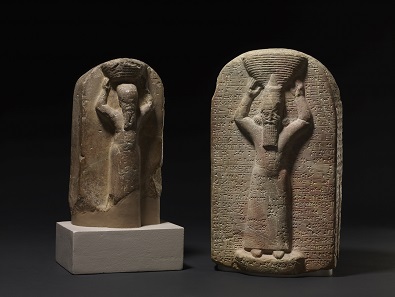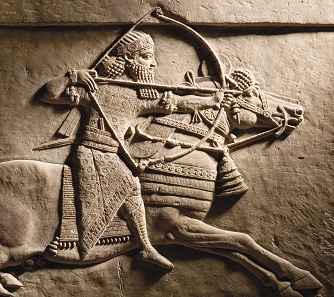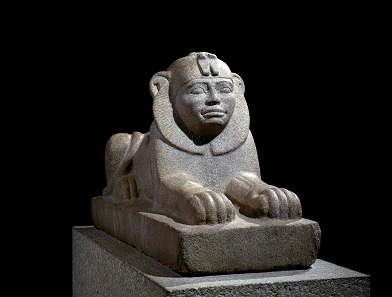August 30, 2018 – From November 8, 2018 until February 24, 2019, you can discover the world of ancient Assyria through the life and legacy of its last great ruler, King Ashurbanipal at the British Museum. The BP exhibition “I am Ashurbanipal: king of the world, king of Assyria” transports you back to ancient Iraq in the 7th century BC, when Ashurbanipal became the most powerful person on earth. From his capital at Nineveh, he ruled a vast and diverse empire, shaping the lives of peoples from the shores of the eastern Mediterranean to the mountains of western Iran.
Stone stele depicting Ashurbanipal (right), shown with a ritual basket on his head with cuneiform inscription, South Iraq, Marduk temple (Babylon), 668-665 BC. His brother Shamash-shumu-ukin (left) carved with cuneiform inscription, South Iraq, Temple of Nabu (Borsippa), 668-655 BC. Image: The Trustees of the British Museum.
How did one man negotiate family politics, the pressures of kingship, and the will of the gods? Ashurbanipal, proud of his scholarship, assembled the greatest library in existence during his reign. Guided by this arsenal of knowledge, he defined the course of the empire and boldly asserted his claim to be ‘king of the world, king of Assyria’.
Relief detail of Ashurbanipal hunting on horseback. Nineveh, Assyria, 645-635 BC. Image: The Trustees of the British Museum.
This is the first ever major exhibition to explore the life of Ashurbanipal in such depth. The exhibition tells Ashurbanipal’s remarkable story through the vivid narratives recorded on his palace sculptures, the hundreds of cuneiform texts that survive from his library, and from the wealth of objects discovered by archaeologists working in the region. Innovative displays bring to life the tumultuous story of Ashurbanipal’s reign; his conquest of Egypt, the crushing defeat of his rebellious older brother, and his ruthless campaigns against all who defied his rule.
Ivory plaque of a lioness mauling a man, ivory, gold, cornelian, lapis lazuli, Nimrud, 900-700 BC. Image: The Trustees of the British Museum.
The exhibition immerses visitors in the life at the great Assyrian court. Massive stone sculptures, intricately carved reliefs, painted glazed bricks and rare wall paintings evoke the splendour of the cities and palaces. Delicately carved ivories, extravagant metalwork, cosmetic vessels and gold ornaments show how the elites lived in splendour. Ornate chariot fittings and elaborate weaponry reveal how this was an age of conflict, as rival kings fought for power and glory. Ashurbanipal’s prowess as a valiant warrior is recorded on a series of vividly carved reliefs in the British Museum’s collection that depict the royal lion hunt. Lion hunts were drama-filled public spectacles staged within the hunting grounds at Nineveh.
Granite sphinx of Taharqo, Kawa, Sudan, c. 680 BC. Image: The Trustees of the British Museum.
Ashurbanipal claimed to be unlike his predecessors for he could read, write and debate with expert scholars. During his reign he assembled a unique and visionary library at his palace in Nineveh. Knowledge was power; this library was a practical tool that helped the king to manage his empire. Using the British Museum’s collection of documents dating to Ashurbanipal’s reign, the exhibition will recreate the king’s great library to evoke its scale and present its contents and significance.
Photograph of Iraqi archaeologists undertaking training as part of the British Museum’s Iraq Emergency Heritage Management Training Scheme. Image: The Trustees of the British Museum.
Many of the objects featured in the exhibition come from archaeological sites in Iraq such as Nineveh and Nimrud that have been systematically targeted and destroyed by Daesh (IS). The final section of the exhibition highlights the challenges faced in protecting Iraqi cultural heritage under threat and will showcase the work of the ‘Iraq Emergency Heritage Management Training Scheme’. In response to the destruction of heritage sites in Iraq, the British Museum developed this scheme to train Iraqi archaeologists in rescue archaeology and emergency heritage management. An overview of the project’s training and research will be presented to visitors through film footage of the excavations and exclusive interviews with participants.
The British Museum has produced a short teaser to get you excited about your visit.
You can find more information on the exhibition, including a run down of what you need to know about the Assyrians by the curator Gareth Brereton, on the official British Museum website.
Additional information on the Iraq Emergency Heritage Management Training Scheme is also available.








